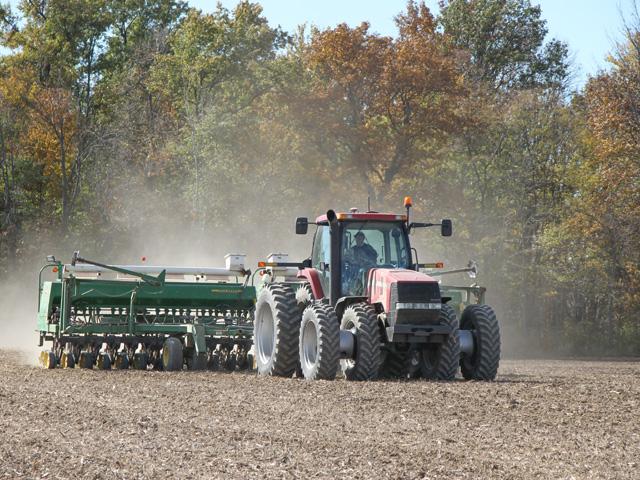Winter Wheat and Cover Crop Seed Outlook
Winter Wheat and Cover Crop Seed Supplies Tight, Prices Up
ANKENY, Iowa (DTN) -- Winter wheat and cover crop seed supplies are tight in some regions due to weather-related production issues, seed industry representatives report. Farmers can also expect higher prices for cover crops and winter wheat seed compared to last year, and in some cases, significantly more.
Cover crop and winter wheat planting have started in some areas or will begin soon. DTN recently surveyed several seed companies and dealers to determine seed availability and pricing.
Seed representatives urge farmers who haven't secured winter wheat -- hard red, soft red and soft white -- and cover crop seed to do so now. Seed is available, but some varieties are short and tough to get, or quantities are limited. A combination of factors contributed to increased seed costs, ranging from higher commodity prices to increased fuel, equipment and processing expenses.
Here are comments from several seed industry representatives. (Editor's note: Some responses were edited for clarity and brevity.)
JEFFREY KOSCELNY, BAYER CROP SCIENCE CEREALS ACCOUNT MANAGEMENT LEAD, ST. LOUIS
Bayer Crop Science's WestBred brand has roughly 70 winter wheat varieties for the western U.S. Supplies are extremely tight in many areas, though availability does vary. In the Central and Southern Plains and even Montana, the drought affected harvest. Yields were down.
The good news is a lot of farmers booked early. For those that are waiting to see how much (winter wheat) they will plant, I would say they have to take action now. A lot of farmers are waiting to see if moisture is coming to get plants up. I would suggest talking to your suppliers; there's a lot of seed being moved around. There are semis moving from areas that had a better harvest to areas that didn't.
Seed prices do vary among suppliers. Prices are up year-over-year, primarily driven by the cost of goods. I would expect growers will be paying more for certified wheat seed at the farmgate this year ... in the neighborhood of 15% to 30% more. But I believe that certified single-use-only seed is a good investment for growers because of superior seed quality and performance potential.
P[L1] D[0x0] M[300x250] OOP[F] ADUNIT[] T[]
CHRIS HANSEN, KAUFFMAN SEEDS TECHNICAL AGRONOMY AND SALES, HUTCHINSON, KANSAS
We cover central and western Kansas, along with northern Oklahoma. For winter wheat seed, we are associates for Limagrain Cereal Seeds, Westbred, AgriPro Wheat, Oklahoma Genetics, Inc., and Kansas Wheat Alliance.
Winter wheat seed supplies are really tight in our region. Many of the more popular varieties have been booked up since early August. We have experienced orders for certified seed starting to come in before harvest in recent seasons. Seed wheat production was down this year due to drought and hotter temperatures at grain fill. Our production under irrigation was off by as much as 10% to 20% from a year ago. It has led to the situation we're at with tighter supplies for this fall.
Cover crop seed supply is fairly tight as well but is more species specific. Some brassicas and legumes are not quite as tight as we are seeing in fall-planted cereals such as rye and triticale. Demand is up for cover crop seed for fall-planted forages this year with the drought conditions we're experiencing in our area. Producers are trying to find other options for extra feed for cattle as grazing or haying options.
Winter wheat seed prices have increased 20% to 30% this year compared to last year. Overall, costs for goods are up and grain prices are up, which really moves the needle on seed wheat prices. That's most of the cost of seed.
Some cover crop seed prices have gone up. Some have only seen a nominal price increase. Products like triticale and cereal rye have seen the greatest rise in cost year-over-year in cover crops.
PAT HOLLOWAY, BECK'S SUPERIOR HYBRIDS FIELD SALES AGRONOMIST, ATLANTA, INDIANA
For winter wheat and some of our cover crop seed, availability is pretty good. The winter wheat harvest happened a couple months ago and yields were pretty good, at least where we grow a lot of our seed crop. We sell eight varieties of soft red winter wheat.
We're going into the fall relatively dry, which can make for good winter wheat and cover crop seeding conditions. And, it looks like we're going to have an earlier-than-normal harvest, which will provide a little more time to get those fall-seeded crops established.
Cereal rye is far and away the most common cover crop seed we sell, but there's all sorts of different cover crops used that we sell. There's mixes of clovers and oats. If you want something that will terminate during the winter, try radishes.
If farmers are looking at buying seed for this fall, or next year, I think they're going to see at least a few percent price increase with all the input prices, rent prices and everything going up.
JON KOSTER, OWNER of JON KOSTER SEEDS, ST. ANSGAR, IOWA
Just like everything else in agriculture, cover crop seed prices have gone up compared to last year. A year ago, there was a pretty widespread drought in Canada, and that put some pressure on small grains.
We had a good crop of locally sourced cover crop seed this year. We have a lot of seed available, such as oats and cereal rye, but supplies could get tight. You will want to get seed bought before we get going too far into harvest.
Matthew Wilde can be reached at matt.wilde@dtn.com
Follow him on Twitter @progressivwilde
(c) Copyright 2022 DTN, LLC. All rights reserved.






